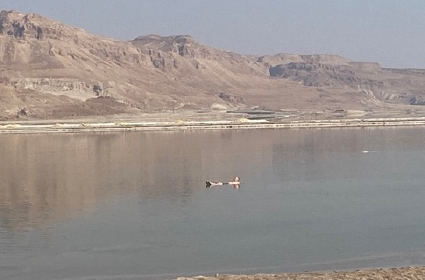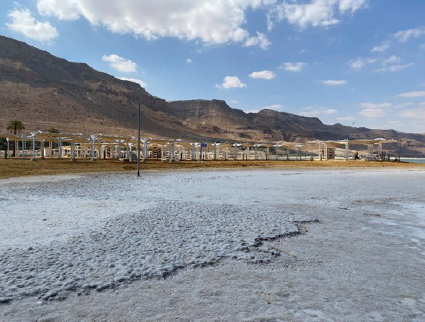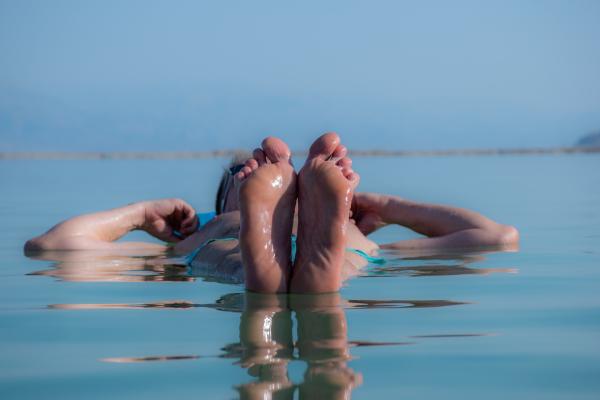The Climate of the Dead Sea
The Dead Sea:
- Is the lowest place on earth, approximately 400 meters below sea level.
 Has the highest barometric pressure on earth (800 mm Hg) with a partial oxygen pressure of 8% more than sea level, resulting in 5% more oxygen.
Has the highest barometric pressure on earth (800 mm Hg) with a partial oxygen pressure of 8% more than sea level, resulting in 5% more oxygen.- Unique ultraviolet radiation in which exposure to ultraviolet A (UVA) and ultraviolet B (UVB) radiation is reduced as rays must pass through an additional 400 meters, and high temperatures cause significant evaporation of the Dead Sea salts creating a “vapor haze” blocking radiation. Harmful UVB radiation is blocked more than UVA radiation.
- Low humidity (below 40%), little rain (a few millimeters per year), and 330 days of sunshine annually.
Climatotherapy, the Dead Sea, Psoriasis, and a Bit of Science
Psoriasis is a chronic autoimmune disease that causes a rash with itchy, scaly patches, most commonly on the knees, elbows, lower back, and scalp. It can be extremely painful, causing itching, burning, and soreness. It usually occurs in cycles, with flare-ups lasting for weeks to months and then subsiding.
Climatotherapy, climate therapy, is one of the oldest forms of medical tourism [1] and involves travel to what is believed to be a more beneficial climate. For psoriasis, the environment of the Dead Sea is “just what the doctor ordered.” In Israel, citizens with psoriasis receive four weeks of government-sponsored treatment at the Dead Sea. Similar climatotherapy is offered and covered in Denmark, Germany, Austria, Sweden, and Norway. There are limited scientific reports, often limited series.
- In 2020, a study examined the results of 18 Danish patients who spent 28 days bathing and escalating doses of UVB exposure at the Dead Sea. Patients experienced an 88% reduction in the Psoriasis and Severity Index, a tool used to grade the severity of psoriatic lesions. There was complete clearance of lesions in 55.6% of patients, but these beneficial effects were lost after about three months.
- A 2022 follow-up study of these patients examined blood samples. Skin biopsies showed immediate reductions in skin biomarkers, including T cells and other cell types known to play a role in psoriasis. No effects on blood parameters, including cholesterol, glucose, and triglyceride, were noted after treatment. As in the 2020 study, the biomarker changes were not long-lasting, returning to initial levels three months after treatment.
- Rheumatoid arthritis, knee osteoarthritis, and musculoskeletal diseases have also touted the benefits of balneotherapy, bathing, or spa treatment, as would come from prolonged bathing in the Dead Sea. A review found significant short-term improvements in patient symptoms. With no control group and few patients, these studies are not conclusive.
- Respiratory diseases like asthma, emphysema, and chronic obstructive pulmonary disease (COPD) have reported benefits from therapy at the Dead Sea. One study noted improvement in asthma, attributed to the absorption of magnesium [2], resulting in anti-inflammatory effects. A study evaluating 11 patients with COPD found an increase in arterial blood gases and exercise ability after a three-week stay at the Dead Sea, where ambient oxygen levels are greater.
What Makes up Dead Sea Water?
The excessive salt content increases the density of the water, increasing our buoyancy and making it almost impossible to sink in the Dead Sea, although it is a myth that you cannot drown.
 The total concentration of salt and minerals is about 32%, compared to about 3% in the ocean. It has a salt content of about 320 grams/liter, consisting primarily of potassium chloride, magnesium chloride, calcium chloride, and sodium chloride.
The total concentration of salt and minerals is about 32%, compared to about 3% in the ocean. It has a salt content of about 320 grams/liter, consisting primarily of potassium chloride, magnesium chloride, calcium chloride, and sodium chloride.
The high salt and mineral concentration make it impossible for plants, insects, or fish to survive in the Dead Sea; however, some microorganisms have been found at its bottom.
The mud from the bottom of the Dead Sea is very rich in minerals, including magnesium, calcium, sodium, zinc, potassium, and sulfur. People smear it over their bodies before they enter the water. It is supposed to benefit the skin, promoting elasticity and smoothing the appearance of lines and wrinkles. As you might expect, skin care products containing Dead Sea salts and mud are a huge business, generating $721 million in 2021.
Should the Dead Sea be a UNESCO World Heritage Site?
The Dead Sea is shrinking at about a meter a year, primarily because its main inflow, the Jordan River, has been largely diverted to irrigate farms. Mineral mining factories extract valuable potash, bromine, and magnesium from the Dead Sea, pumping water into massive evaporation ponds and only replacing about one-half of the water removed. As with many problems in the Middle East, various plans have been suggested, but none have been agreed upon or implemented.
[1] Perhaps the most well-known example is the idea that individuals with TB would do better in mountain environments with plenty of fresh air. Ironically, some scientific evidence shows that mycobacterium does not reproduce as quickly at higher altitudes with less oxygen.
[2] Magnesium acts as a bronchodilator, expanding the airways.
All photos by the author




